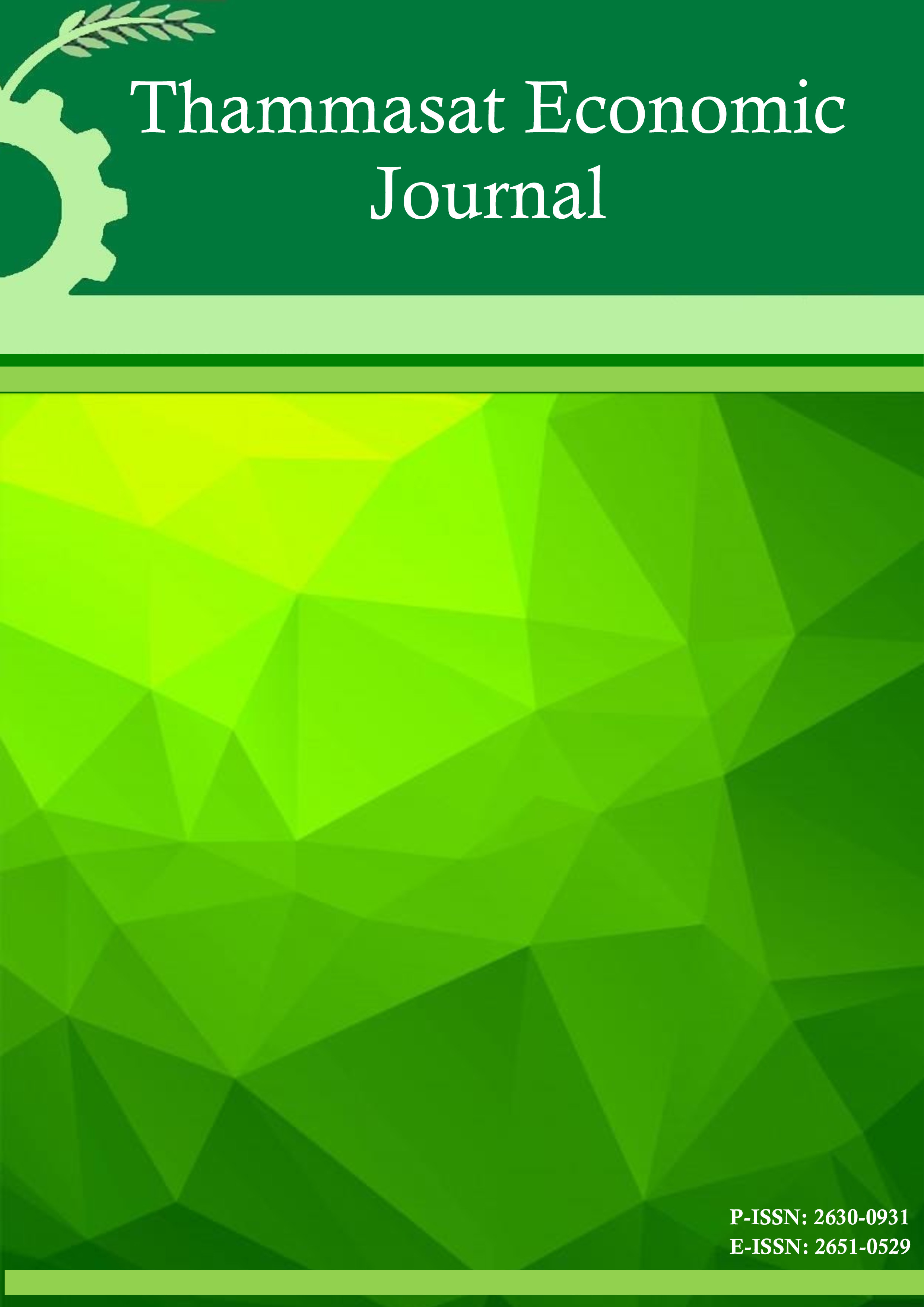การวิเคราะห์การตัดสินใจเลือกซื้อหนังสือทางช่องทางพาณิชย์อิเล็กทรอนิกส์
กรณีศึกษาจังหวัดกรุงเทพมหานคร
บทคัดย่อ
งานศึกษานี้เป็นการศึกษาเชิงประจักษ์ที่ศึกษาถึง ปัจจัยที่มีอิทธิพลต่อการตัดสินใจเลือกซื้อหนังสือผ่านช่องทางพาณิชย์อิเล็กทรอนิกส์ และศึกษาค่าความยืดหยุ่นของอุปสงค์ต่อราคาเปรียบเทียบและค่าความยืดหยุ่นของอุปสงค์ต่อรายได้ โดยใช้แบบจำลองทางเศรษฐมิติในการประมาณค่าผ่านแบบจำลองโลจิต รวมทั้งศึกษาราคาความเสี่ยงและผลประโยชน์ในการซื้อหนังสือทางพาณิชย์อิเล็กทรอนิกส์ ในมุมมองของผู้บริโภค โดยประยุกต์ใช้ทฤษฎีความเต็มใจจ่ายและการวัดผลของการเปลี่ยนแปลงต่อสวัสดิการผู้บริโภค
ผลการศึกษาจากแบบจำลองโลจิตพบว่า ราคาเปรียบเทียบระหว่างช่องทางพาณิชย์อิเล็กทรอนิกส์และช่องทางปกติ เป็นปัจจัยที่มีอิทธิพลสูงสุดต่อการตัดสินใจซื้อหนังสือทางพาณิชย์ อิเล็กทรอนิกส์ของผู้บริโภค และพบว่าค่าความยืดหยุ่นของอุปสงค์ต่อราคาเปรียบเทียบมีค่ามากกว่าค่าความยืดหยุ่นของอุปสงค์ต่อรายได้ อย่างไรก็ตามในกรณีนี้ไม่สามารถเปรียบเทียบผลทางราคาโดยเปรียบเทียบกับผลทางรายได้ได้อย่างชัดเจน เนื่องจากปัจจัยรายได้ไม่ส่งผลต่อพฤติกรรมการตัดสินใจของผู้บริโภคอย่างมีนัยสำคัญ
ทางด้านผลการศึกษาความเต็มใจจ่ายพบว่า ความเสี่ยงในการซื้อหนังสือทางพาณิชย์อิเล็กทรอนิกส์ในมุมมองของผู้บริโภคที่ไม่เคยซื้อ (CV) มีค่ามากกว่าผลประโยชน์ในมุมมองของผู้ที่เคยซื้อ (EV) โดยที่ CV มีค่าเฉลี่ยเท่ากับร้อยละ 23.10 และ EV มีค่าเฉลี่ยเท่ากับร้อยละ 14.05
เอกสารอ้างอิง
2. ศิริวรรณ เสรีรัตน์ (2546) การบริหารการตลาดยุคใหม่, (กรุงเทพฯ: บริษัทธรรมสาร จำกัด).
3. ปริย วงศ์วานชาตรี (2544), พฤติกรรมของผู้ใช้อินเตอร์เน็ตและปัจจัยที่มีอิทธิพลต่อพาณิชย์อิเล็กทรอนิกส์, วิทยานิพนธ์ปริญญาวิทยาศาสตร์มหาบัณฑิต คณะเศรษฐศาสตร์ มหาวิทยาลัยเกษตรศาสตร์.
4. ปานแก้วตา นิลออ (2550), การศึกษารูปแบบพาณิชย์อิเล็กทรอนิกส์สำหรับการซื้อขายหนังสือมือ
5. สอง, งานวิจัยเฉพาะกรณีมหาบัณฑิต สาขาการจัดการเทคโนโลยี วิทยาลัยนวัตกรรม อุดมศึกษามหาวิทยาลัยธรรมศาสตร์.
6. ศูนย์เทคโนโลยีอิเล็กทรอนิกส์และคอมพิวเตอร์แห่งชาติ (2545), กรอบนโยบายเทคโนโลยี
7. สารสนเทศ ระยะ พ.ศ. 2544-2553 ของประเทศไทย, สำนักงานเลขานุการคณะกรรมการ
8. เทคโนโลยีแห่งชาติ กระทรวงวิทยาศาสตร์ เทคโนโลยีและสิ่งแวดล้อม.
9. ศูนย์เทคโนโลยีอิเล็กทรอนิกส์และคอมพิวเตอร์แห่งชาติ (2550), รายงานผลการสำรวจกลุ่มผู้ใช้อินเทอร์เน็ตในประเทศไทย ปี 2550, กระทรวงวิทยาศาสตร์เทคโนโลยีและสิ่งแวดล้อม.
10. สำนักงานเลขานุการคณะกรรมการเทคโนโลยีสารสนเทศแห่งชาติ (2545), แผนแม่บทเทคโนโลยีสารสนเทศและการสื่อสารของประเทศไทย พ.ศ. 2545-2549, กระทรวงวิทยาศาสตร์-เทคโนโลยีและสิ่งแวดล้อม.
11. สำนักงานสถิติแห่งชาติ (2551), สำรวจสถานภาพการพาณิชย์อิเล็กทรอนิกส์ของประเทศไทยพ.ศ.2551, กระทรวงเทคโนโลยีสารสนเทศและการสื่อสาร.
12. Acock, Alan C. (2008), A Gentle Introduction to Stata, 2ndedition, (Stata Press).
13. Fink, A. (1995), How to sample in surveys, The Survey Kit v.6, (SAGE Publications).
14. Freeman, Myrick A. (2003), The Measurement of Environmental and Resource Values: Theory and Methods, 2ndedition, (Resources for the Future, Washington, D.C.).
15. Pindyck, R., and Rubinfeld, D. (2007), Microeconomics, 5thedition, (New York: Prentice Hall).
16. Yamane, T. (1967), Statistics; An Introductory Analysis, 2nd edition, (New York University, HAPPER & ROW).
17. Koivumäki, T., Svevto, R., Pertunen, J., and Oinas-Kukkonen, H. (2002), Consumer choice behavior and electronic shopping systems – a theoretical note, Netnomics, 4, pp. 131-144.
18. Koyuncu C. and Lien D. (2003), E-commerce and consumer’s purchasing behavior, Applied Economics, 35, pp. 721–726.
19. Lowengart, O., and Tractinsky, N. (2001), Differential effects of product category on shoppers’ selection of web-based stores: A probabilistic modeling approach, Journal of Electronic Commerce Research, 2(4),pp. 142-156.
20. Yang, B., Lo, P., and Lester, D. (2003), Purchasing textbooks online, Applied Economics, 35, pp. 1265-1269.







